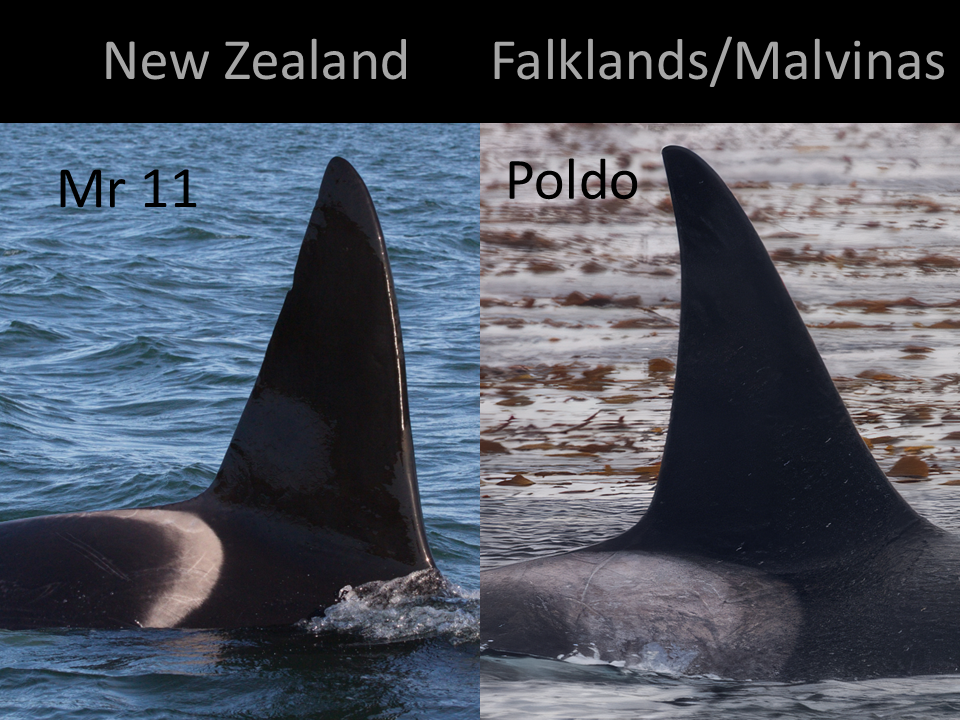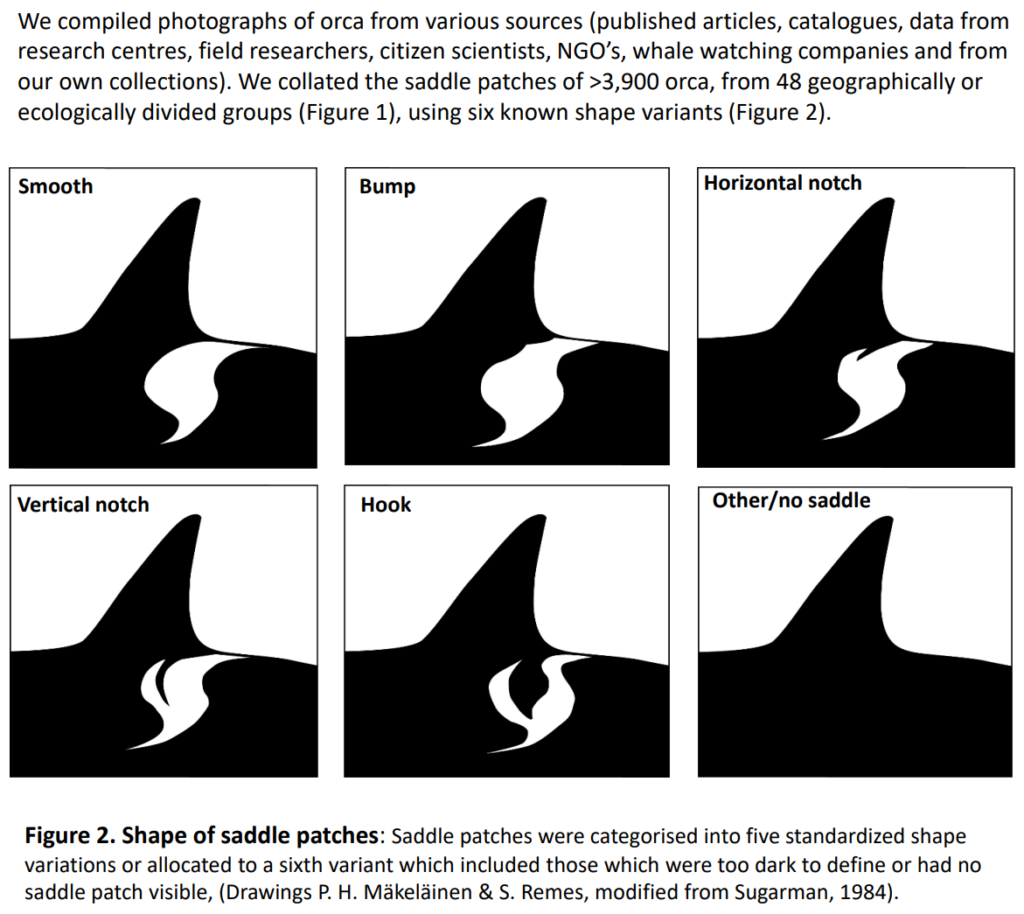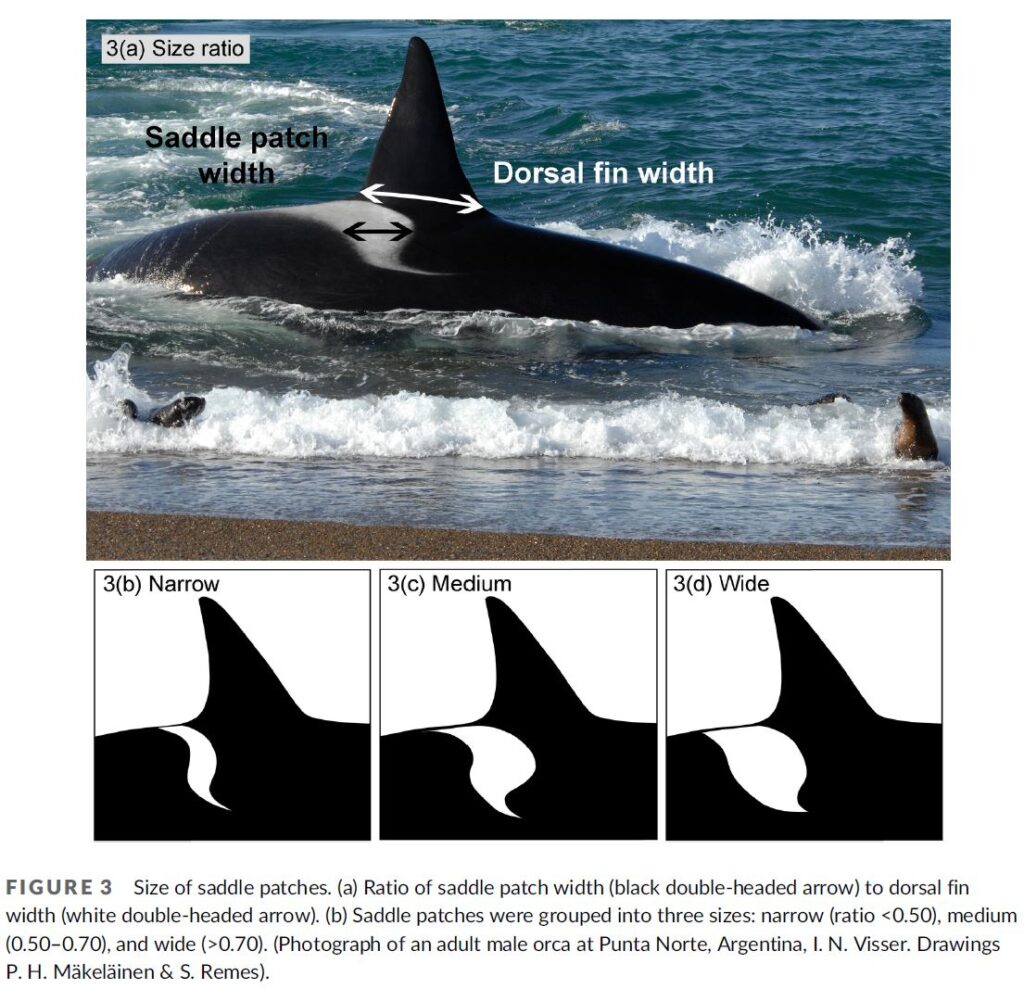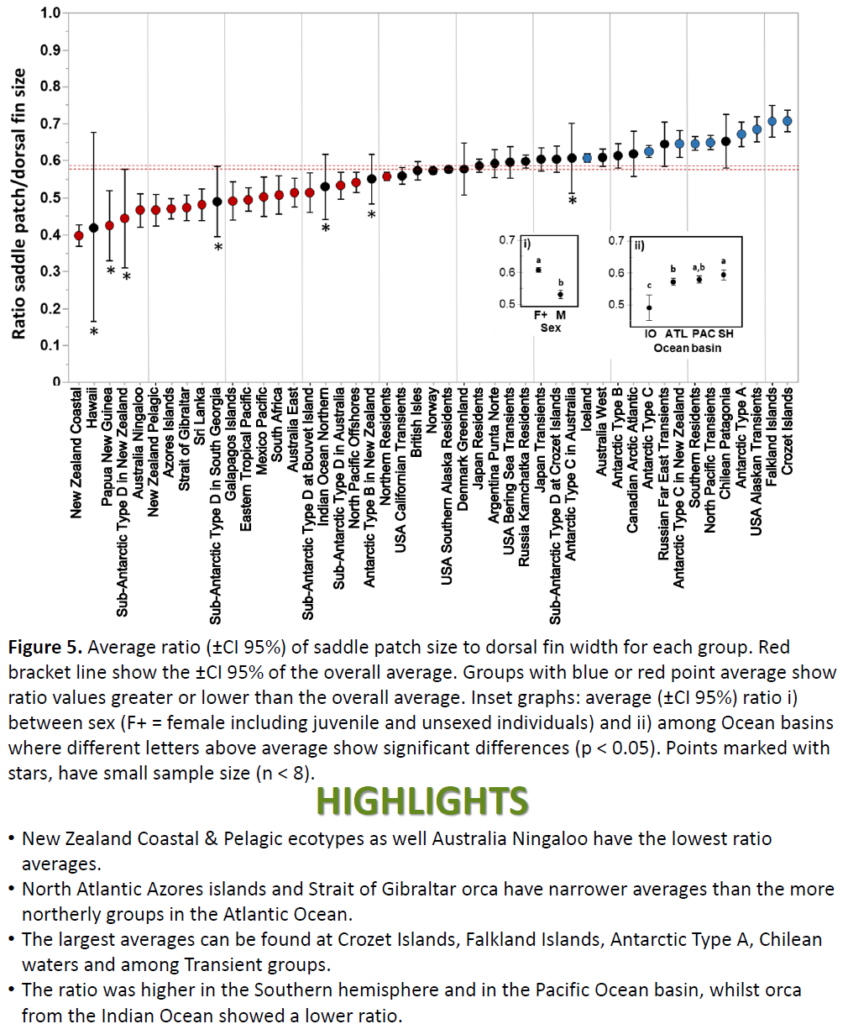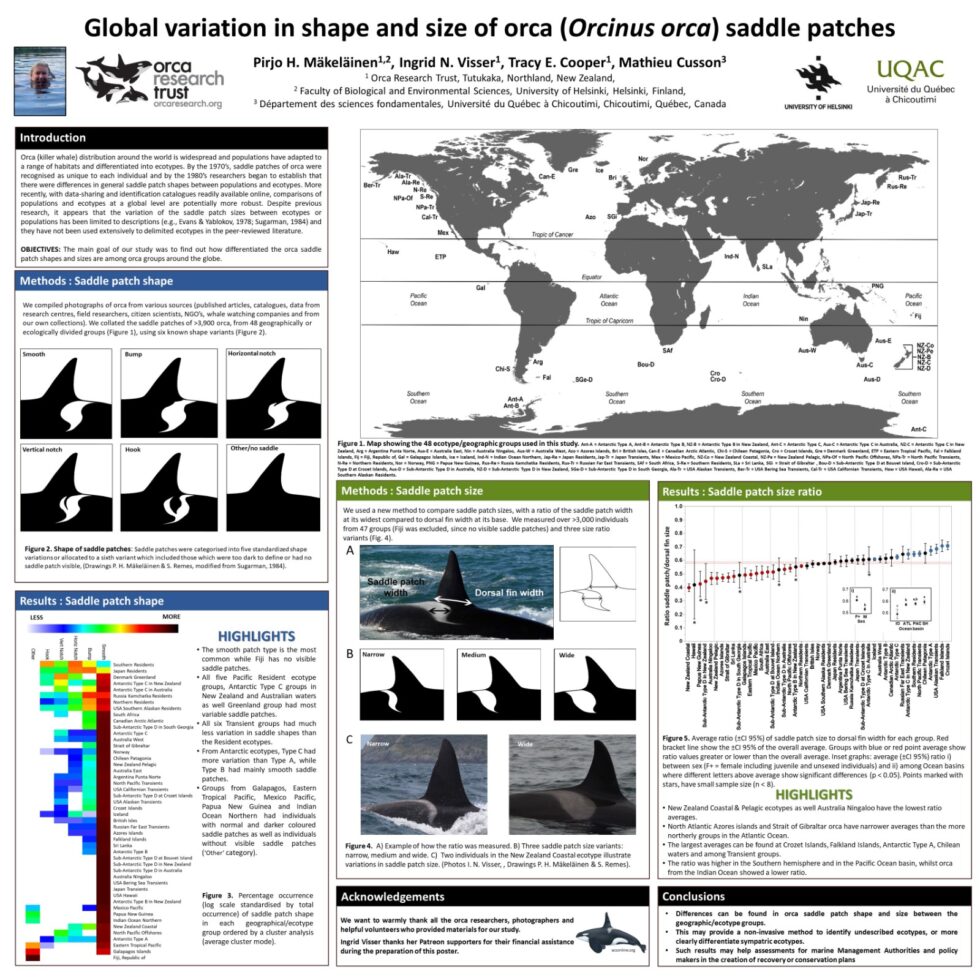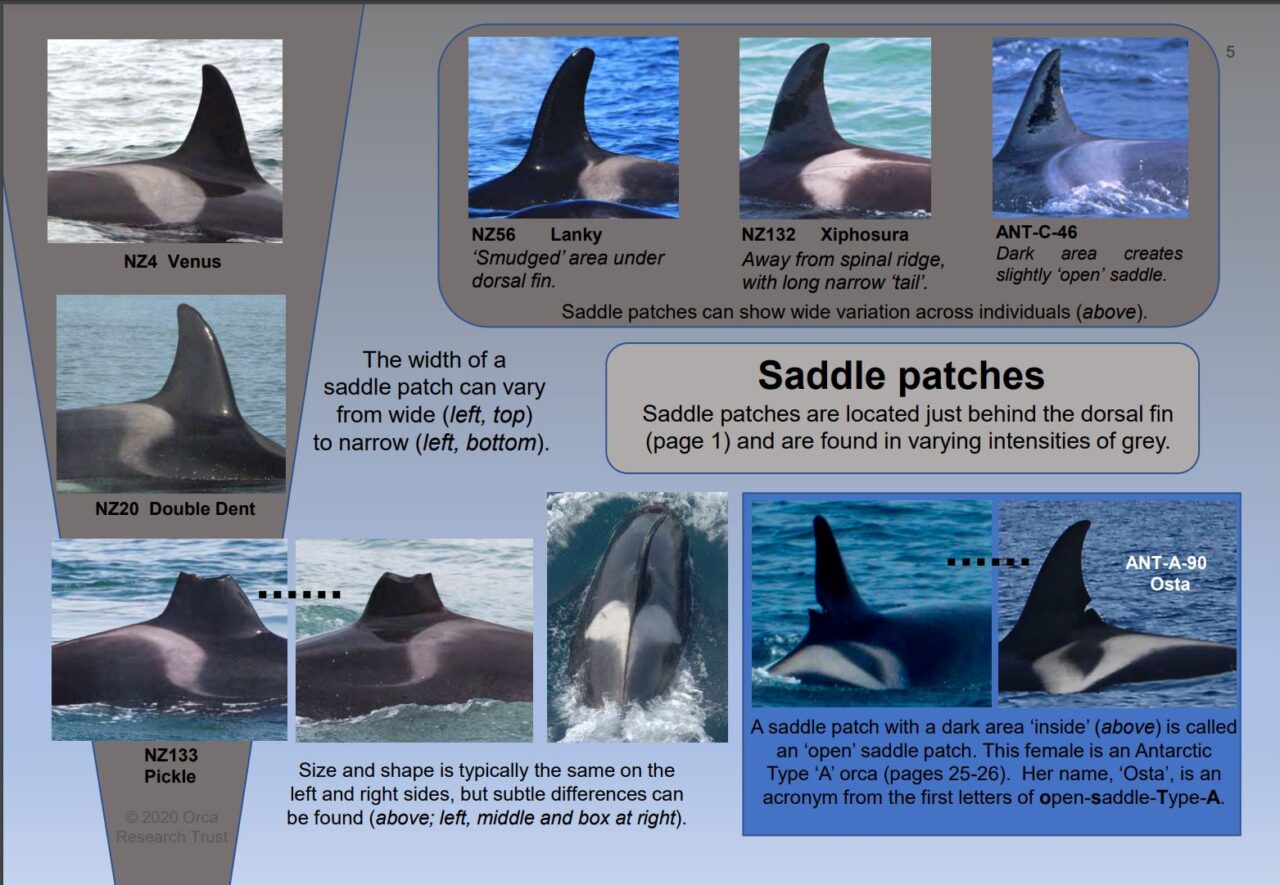Saddle patches scientific paper (2024)
Identifying individual orca is typically done by comparing the saddle patches with the size and shape of the dorsal fin, along with scars and other unique features. The saddle patches are grey pigmented areas which are unique to each individual and even vary between the left and right of each individual. Some examples are given in the New Zealand Identification Guide, on page 5 and at the bottom of this website page.
In this study, published in 2024, nearly 4,000 orca from 48 geographic groups / ecotypes were used to investigate if there was a worldwide variation in saddle patch shapes and sizes. Turns out there is! – However that variation fits within just six shape categories and more than 97% of saddle patches fit into just five categories.
But when it comes to saddle patch size the distinctions ranged more, with extremely narrow saddle patches (from the Coastal ecotype in New Zealand waters) to very wide ones (in the waters around the Crozet and the Falkland Islands – also known as Islas Malvinas).
More details about the study are given further down on this page, but you can download the paper for free from this link if you want to read the entire publication;
Mäkeläinen, P. H., Visser, I. N., Cooper, T. E. & Cusson, M. (2024). Worldwide variation in shape and size of orca (Orcinus orca) saddle patches. Marine Mammal Science, 41(1), e13171 (13171-13118). https://doi.org/10.1111/mms.13171
We hope that our results will help identify that there are many more geographic groups / ecotypes than is currently recognised by most researchers – and help to delimit these and any other yet to be described populations. Such information is vital for the management of each unique population of orca.
Here is the Abstract (a scientific summary of the publication)
The global distribution of Orcinus orca (orcas/killer whales) encompasses populations which differ from each other. Saddle patch shapes and sizes were compared for nearly 4,000 individuals, in 48 geographically or ecologically divided groups/populations/ecotypes (GP/E), in four Ocean Basins. Some Antarctic GP/E had five shapes, contrary to previous studies, which found only one shape in these Southern GP/E. Pacific Resident ecotypes had the highest variation in saddle patch shapes. Globally, the most common shape was the ‘Smooth’ category. Saddle patch sizes were measured using a ratio of the width of the saddle patch compared to the width of the dorsal fin base and averaged within each GP/E. The narrowest saddle patches were observed in New Zealand waters. The widest saddle patches were observed at the Crozet Islands and the Falkland Islands (Islas Malvinas). Globally, we found that the shape and size of saddle patches helped to define various GP/E, reinforcing earlier predictions that this pigmentation may be indicative of population divisions. Our findings may help with describing poorly defined or undescribed ecotypes.
Such results may therefore aid assessments by management authorities/policy makers and provide levels of guidance in the creation of conservation or recovery plans.
For our analysis, we based the shapes on a robust set of criteria first suggested in the 1980’s and added another category to include shapes that didn’t fall into the previously recognised ones.
And although the ‘size’ of the saddle patch has been discussed in passing before, it hasn’t really been an aspect that researchers had given much attention to. Therefore, as part of this investigation, we developed a new method to measure the saddle patches that allows for an individual to be of a different size (not only in age, but also in physical population average, as well as in distance from the photographer), by using a ratio measurement. We measured the base of the dorsal fin against the wides part of the saddle patch. From this we divided the saddles into three size categories; Narrow, Medium and Wide.
We found some intriguing results; one of which was that the NZ Coastal orca have (on average) the narrowest saddle patches (at least from within the 48 different groups that we had measured – they are on the top of the graph below). Although some of the orca in NZ also have very wide saddle patches, overall, once again, we are able to show that the New Zealand Coastal orca are a unique ecotype.
There is still a lot to learn and discover about orca, even when looking at their basic pigmentation. For example, just within this dataset the number of images that we had to work with for some of the groups is very sparse and requires more field work.
Conference poster 2022
The Society of Marine Mammalogy scientific conference was held 1-5 August 2022 in Florida, USA. Three members of the Orca Research Trust and Punta Norte Orca Research attended virtually and presented this poster with the preliminary results from our study. It can be downloaded as a pdf by clicking on the poster image, to the left, or on the hyperlink in the title below.
Mäkeläinen P.H., Visser I.N., Cooper T.E. & Cusson M. 2022. Global variation in shape and size of orca (Orcinus orca) saddle patches (poster ID# 2022490). Poster presented at the 24th Biennial Conference on the Biology of Marine Mammals; 1-5 August; Palm Beach, Florida.
Identifying orca is typically done using the size and shape of the dorsal fin, along with scars and concurrently comparing the saddle patches – which are unique to each individual and even vary between the left and right of each individual. Some examples are given in the New Zealand Identification Guide, on page 5 (and an image of that is at the bottom of this page)
For this poster we focused on two main aspects; the shape of a saddle patch and the size of a saddle patch.
New Zealand Orca Identification Guide
This page from the New Zealand Orca Identification Guide shows some of the variations of sadde patch shapes and sizes just within the New Zealand Coastal orca ecotype. The full publication can be downloaded from New Zealand Identification Guide.

